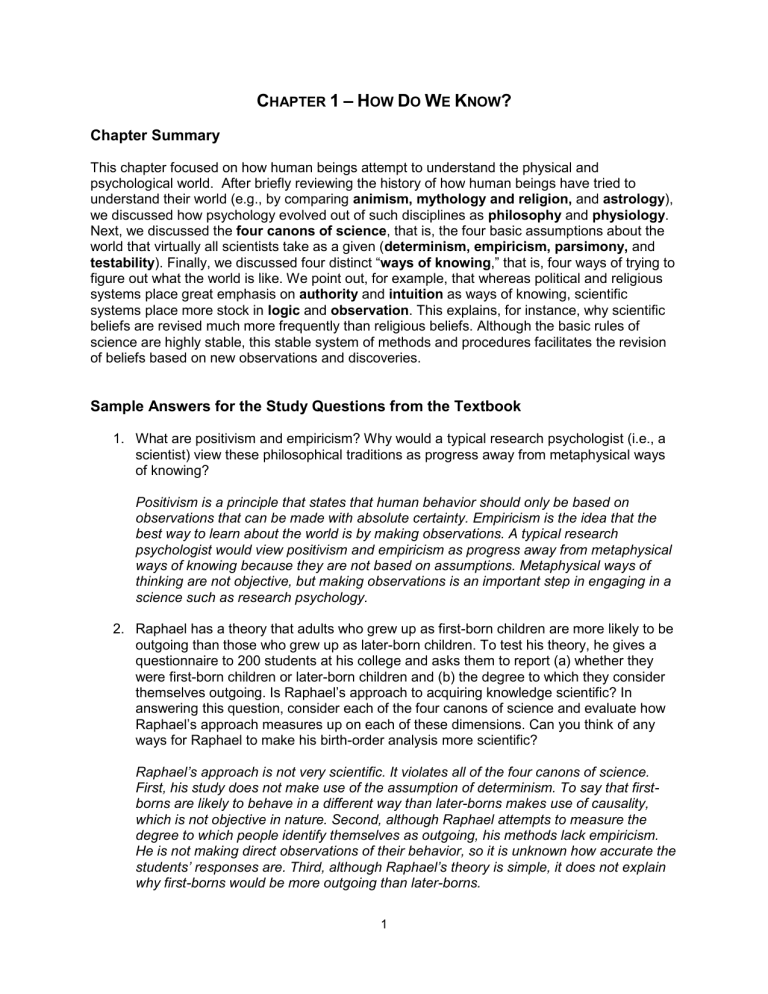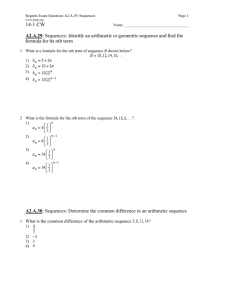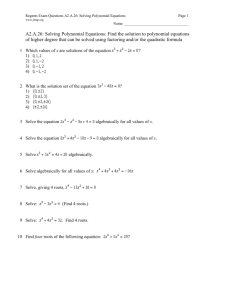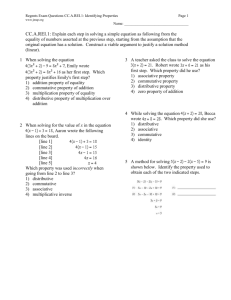- Test Bank Instant

C
HAPTER
1 – H
OW
D
O
W
E
K
NOW
?
Chapter Summary
This chapter focused on how human beings attempt to understand the physical and psychological world. After briefly reviewing the history of how human beings have tried to understand their world (e.g., by comparing animism, mythology and religion, and astrology ), we discussed how psychology evolved out of such disciplines as philosophy and physiology .
Next, we discussed the four canons of science , that is, the four basic assumptions about the world that virtually all scientists take as a given ( determinism, empiricism, parsimony, and testability ). Finally, we discussed four distinct “ ways of knowing ,” that is, four ways of trying to figure out what the world is like. We point out, for example, that whereas political and religious systems place great emphasis on authority and intuition as ways of knowing, scientific systems place more stock in logic and observation . This explains, for instance, why scientific beliefs are revised much more frequently than religious beliefs. Although the basic rules of science are highly stable, this stable system of methods and procedures facilitates the revision of beliefs based on new observations and discoveries.
Sample Answers for the Study Questions from the Textbook
1. What are positivism and empiricism? Why would a typical research psychologist (i.e., a scientist) view these philosophical traditions as progress away from metaphysical ways of knowing?
Positivism is a principle that states that human behavior should only be based on observations that can be made with absolute certainty. Empiricism is the idea that the best way to learn about the world is by making observations. A typical research psychologist would view positivism and empiricism as progress away from metaphysical ways of knowing because they are not based on assumptions. Metaphysical ways of thinking are not objective, but making observations is an important step in engaging in a science such as research psychology.
2. Raphael has a theory that adults who grew up as first-born children are more likely to be outgoing than those who grew up as later-born children. To test his theory, he gives a questionnaire to 200 students at his college and asks them to report (a) whether they were first-born children or later-born children and (b) the degree to which they consider themselves outgoing. Is Raphael ’s approach to acquiring knowledge scientific? In answering this question, consider each of the four canons of science and evaluate how
Raphael ’s approach measures up on each of these dimensions. Can you think of any ways for Raphael to make his birth-order analysis more scientific?
Raphael’s approach is not very scientific. It violates all of the four canons of science.
First, his study does not make use of the assumption of determinism. To say that firstborns are likely to behave in a different way than later-borns makes use of causality, which is not objective in nature. Second, although Raphael attempts to measure the degree to which people identify themselves as outgoing, his methods lack empiricism.
He is not making direct observations of their behavior, so it is unknown how accurate the students’ responses are. Third, although Raphael’s theory is simple, it does not explain why first-borns would be more outgoing than later-borns.
1
It lacks parsimony because it does not explain why personalities should depend on birth order. Fina lly, Raphael’s theory is not very testable. The main item that is lacking is the operational definition of “outgoing”. Since he is asking students to indicate to what degree they believe they are outgoing, this is a subjective type of measurement.
“Outgoing” to one student may mean something different than it does to another. It is impossible to make comparisons unless the degrees of outgoing are the same for everyone.
Raphael can make his birth-order analysis more scientific in several ways. Without knowi ng each student’s birth order position, he should observe them interacting in groups and make notes on their behaviors. He can define “outgoing” by recording the number of times a person contributes an idea to the group, engages in a conversation, etc. Rat her than administer a questionnaire that asks for the student’s own ranking of how outgoing he or she is, he could use a personality test that asks questions about how often one sees friends each week, how many times one makes phone calls to friends, etc.
3. Gloria has a theory that people who are born between July 23rd and August 22nd (i.e.,
“Leos”) are more likely to be outgoing than people who are born at other times of the year. In support of her theory, she notes (a) that most of the Leos she knows are outgoing and (b) that she is very good at correctly guessing the astrological sign of Leos when she meets them. Is Gloria ’s approach to knowledge acquisition scientific? In answering this question, consider each of the four canons of science and evaluate how
Gloria ’s approach measures up on each of these dimensions. Can you think of any ways for Gloria to make her astrological analysis more scientific?
Gloria’s approach to knowledge acquisition is not scientific. It violates all of the four canons of science. First, she does not use determinism to test her theory. She states that most Leos she knows are outgoing. However, it is possible that most people that
Gloria knows overall are outgoing. Correlating group membership (being a Leo) with being outgoi ng is assumptive in nature and not scientific. Second, Gloria’s way of acquiring knowledge is not empirical. Simply thinking of the Leos that she knows and remembering them as outgoing is not an observation. In addition, although she sometimes observes outgoing behavior and then makes a guess that the person is a
Leo, she does not allow her theory to be disproved. She may have met many shy Leos and never realized it because she neglected to ask them if they were a Leo. Third,
Gloria’s theory is simple, but it does not explain why Leos would be more outgoing than any other astrological signs; therefore, it lacks parsimony. Finally, Gloria’s methods are not testable. Although she is observing the behaviors of people that she meets, she does not allow her methods to be falsifiable. Once she observes the outgoing behaviors that she normally finds in Leos, she asks the person if he or she is a Leo. This is not a scientific way to test her theory.
There are a few ways in which Gloria can make her methods of testing more scientific.
First, she should define what types of behaviors in particular she defines as “outgoing”.
She needs an operational definition for the term. Also, she should ask everyone that she meets if they are a Leo. That way, her theory becomes more testable. The possibility of disproving the theory must be available. For example, if most of the non-outgoing people she meets are also Leos, she must abandon the idea that Leos are more outgoing and accept the fact that she just happens to meet many people with July and August birthdays. She should also objectively observe people rather than question them.
2
Gloria should observe how people interact in a group, rate each person’s level of outgoingness, predict who is a Leo, and then ask them for their birth dates.
4. Although one of the tenets of science is that theories should be based on observable events (empiricism), most of the constructs that psychologists study are not visible to the naked eye. For instance, we can ’t directly observe a person’s true attitudes, beliefs, or thoughts. How, then, can psychology be considered scientific? In answering this question, carefully consider the role of logic, theory testing, and operational definitions.
( Note : Your answer to this question will become more sophisticated after you read
Chapter 2.)
Although psychology studies many unobservable phenomena, it is a science.
Psychology relies heavily on operational definitions that define abstract concepts. For example, memory is an abstract psychological concept that has been studied in depth.
Depending on the study, “memory” can be defined as the number of words a person can recall from a list, the number of faces one can recognize after being exposed to them, etc. Logic is also an important factor in psychology. Psychologists often rely on logical beliefs to help them study certain constructs. For example, it is logical to state that a psychologist studying attraction would look at people who are married vs. people who have just met. If people are married, it is fair to infer that they are (or were at one time) attracted to each other. Their behaviors towards their spouses would likely be different than the interactions between the two people who have just met. Another way in which psychology is scientific is through the testing of theories. Research psychologists always look to disprove a theory before they accept it as being true. Theories in combination with operational definitions allow studies to be replicated. If the same results are not obtained after repeating an experiment, the theory is discarded.
Testbank
Multiple-Choice Questions
1. A vague, mildly favorable personality description that most people would consider highly selfdescriptive is called:
A) a Rorschach portrayal
B) an intuitive personality portrait
C) an astrological reading
D) a Barnum description
ANS: D REF: Introduction: What This Text Is About
2. According to the text, which of the following is NOT an example of a metaphysical system?
A) animism
B) mythology
C) astrology
D) philosophy
ANS: D REF: A Brief History of Human Knowledge
3
3. The belief that natural phenomena (e.g., the sun, the wind) are alive is referred to as:
A) animism
B) paleoanthropism
C) primitivism
D) naive realism
ANS: A REF: A Brief History of Human Knowledge
4. Most people agree that __________ was the founder of experimental psychology.
A) Gustav Fechner
B) Carl Jung
C) Hermann von Helmholtz
D) Wilhelm Wundt
ANS: D REF: A Brief History of Human Knowledge
5. Metaphysical explanations violate:
A) common sense
B) established physical laws
C) logical rules of reasoning
D) conversational norms
ANS: B REF: A Brief History of Human Knowledge
6. As the term metaphysical is used in the text, metaphysical explanations for human behavior are based on:
A) indirect observations of events
B) supernatural phenomena
C) philosophical reasoning
D) the scientific method
ANS: B REF: A Brief History of Human Knowledge
7. Dr. Rabinowitz believes that the best way to understand the world is through the use of logical reasoning. Dr. Rabinowitz is most likely to be:
A) a psychologist
B) a philosopher
C) a physiologist
D) a political scientist
ANS: B REF: A Brief History of Human Knowledge; Four Ways of Knowing About the World
MSC: WWW
4
8. The two most important historical precursors (forerunners) of experimental psychology were:
A) philosophy and physics
B) philosophy and physiology
C) anthropology and biology
D) physics and biology
ANS: B REF: A Brief History of Human Knowledge
9. Fundamental principles that are accepted largely on faith are referred to as:
A) ground rules
B) conjectures
C) canons
D) theologisms
ANS: C REF: A Brief History of Human Knowledge
10. José believes that all events have meaningful, systematic causes. José is:
A) a determinist
B) an empiricist
C) a scientist
D) a philosopher
ANS: A REF: The Four Canons of Science
11. According to the text, phenomena such as illusory correlation and superstitious conditioning are consistent with the basic idea behind:
A) determinism
B) empiricism
C) parsimony
D) testability
ANS: A REF: The Four Canons of Science
12. Superstitious conditioning refers to:
A) lay people’s erroneous assumptions about luck and fate
B) bits of folk wisdom that people are rewarded for expressing
C) the false conditioning of random behaviors
D) a learned aversion toward situations people don’t understand
ANS: C REF: The Four Canons of Science
5
13. Muriel believes that science should be based solely on things that can be observed with absolute certainty. What school of thought is she likely a member of?
A) The Barnum Society
B) logical positivism
C) parsimony
D) phrenology
ANS: B REF: The Four Canons of Science
14 . The origin of the phrase “I got it straight from the horse’s mouth” is a good illustration of the basic principle of:
A) authority
B) logic
C) logical positivism
D) empiricism
ANS: D REF: The Four Canons of Science MSC: WWW
15. Galileo tried to solve the problem of how gravity works by:
A) dropping a heavy and a light cannon ball from the Leaning Tower of Pisa
B) performing a thought experiment
C) rolling balls down a series of inclined planes
D) both B and C are correct
ANS: D REF: The Four Canons of Science; Four Ways of Knowing About the World
16. Maxine believes that ingesting the experimental drug theratonin increases aggressive behavior by making aggressive thoughts highly accessible. Sam believes that ingesting theratonin increases aggressive behavior by (1) making aggressive thoughts highly accessible and (2) making people worry less about the consequences of their behavior. If we knew that theratonin does increase aggressive behavior but knew nothing else, which theory should we prefer?
A) Maxine’s theory – because it is more testable than Sam’s theory
B) Maxine’s theory – because it is more parsimonious than Sam’s theory
C) Sam’s theory – because it is more testable than Maxine’s theory
D) Sam’s theory – because it is more parsimonious than Maxine’s theory
ANS: B REF: The Four Canons of Science
17 . “Occam’s Razor” and “Lloyd Morgan’s Canon” refer to the principle of:
A) parsimony
B) theoretical coherence
C) comprehensiveness
D) testability
ANS: A REF: The Four Canons of Science MSC: WWW
6
18. Which of the following is NOT one of the four canons of science mentioned in the text?
A) determinism
B) empiricism
C) parsimony
D) reliability
ANS: D REF: The Four Canons of Science
19. Falsifiability is closely associated with the idea of:
A) parsimony
B) theoretical coherence
C) comprehensiveness
D) testability
ANS: D REF: The Four Canons of Science
20. Testability is very closely associated with the idea of:
A) operational definitions
B) parsimony
C) logical negativism
D) prelogical operationism
ANS: A REF: The Four Canons of Science
21. “Batting a pitched ball directly over the outfield fence (without bouncing) within the first and third base lines” is a(n) ______________ of a home-run in baseball.
A) operational definition
B) falsifiable description
C) empirical description
D) logical delineation
ANS: A REF: The Four Canons of Science
22. According to Karl Popper, what, more than anything else, makes a field of study scientific?
A) openness to criticism and revision
B) the use of scientific methods and procedures
C) systematic observation of behavior
D) the formulation of theories
ANS: A REF: The Four Canons of Science MSC: WWW
7
23. The four “ways of knowing” emphasized in the text include:
A) authority, intuition, logic, and observation
B) authority, intuition, knowledge, and wisdom
C) perception, intuition, deduction, and application
D) deduction, induction, perception, and sensation
ANS: A REF: Four Ways of Knowing About the World
24 . How would a physicist be likely to rank order the importance of the four “ways of knowing” emphasized in the text? (1= most, 4 = least important)
A) 1. logic, 2. intuition, 3. observation, 4. authority
B) 1. observation, 2. authority, 3. logic, 4. intuition
C) 1. logic, 2. observation, 3. authority, 4. intuition
D) 1. observation, 2. logic, 3. intuition, 4. authority
ANS: D REF: Four Ways of Knowing About the World MSC: WWW
25. According to the text, which of the “ways of knowing” emphasized in the text would be ranked most highly (most favorably) by a politician or minister?
A) logic
B) intuition
C) authority
D) observation
ANS: C REF: Four Ways of Knowing About the World
26. The “Draw-A-Person Test” once used by clinical psychologists is an example of scientists relying on this “way of knowing”:
A) authority
B) logic
C) intuition
D) observation
ANS: C REF: Four Ways of Knowing About the World
8
Hands-On Activity 1 -
Galileo’s Dice
As suggested in the text itself, you should divide students into three or more groups for this activity: (1) “the logical counters of ways,” (2) “the logical expected evaluators,” and (3) one or more groups of “empiricists” who merely roll the dice as many times as possible and keep track of all of their rolls, especially (a) the total number of rolls made, (b) the total number of 9s rolled, and (c) the total number of 10s rolled. A handout that will facilitate this group’s activities appears at the end of these instructions . As soon as each group has had a chance to complete their analysis, I ask all the members of each group to answer the three questions posed at the end of the exercise. You should observe several things:
First, group one should be the only group to have arrived at the exact answer, and they should also be the group who is most confident of their answers (especially when it comes to question
3). Second, unless the empiricists are able to make a great number of rolls, they will often arrive at an incorrect answer (they may obtain more 9s than 10s). Third, once each group has presented their analysis to the other groups, (beginning with the empiricists, moving on the logical expected evaluators, and finishing with the logical counters of ways), you should point out that, on the whole, the conclusions of the three groups are pretty similar. For example, even if one or both groups of empiricists are wrong about which roll is more likely, their estimates of the probabilities should be reasonably close to the theoretical probabilities generated by the logical counters of ways (see below). Incidentally, when you ask the groups to present their findings, you might also get them to include the mean confidence rating of the average group member for questions 2 and 3 – for comparison with the other groups. To avoid confusion here,
I recommend checking the students’ work – with a calculator if necessary – while they’re doing these calculations.
The group with the most difficult job is the first group. Unless someone in the group is pretty good with numbers or probability theory, they are likely to need some coaching to help them generate all of the exact ways of rolling 9 and 10 spots with three dice. While coaching this group a little, and while helping them organize their analysis for presentation to the rest of the class, it’s best to organize the exact ways of rolling both a 9 and a 10 by running through the possibilities systematically. The list of possible rolls appears on the next page:
9
Exact Ways to Roll a 9 Exact Ways to Roll a 10
1, 2, 6 4, 1, 4 1, 3, 6 4, 1, 5
1, 3, 5 4, 2, 3 1, 4, 5 4, 2, 4
1, 4, 4 4, 3, 2 1, 5, 4 4, 3, 3
1, 5, 3 4, 4, 1 1, 6, 3 4, 4, 2
1, 6, 2 4, 5, 1
5, 1, 3 2, 2, 6
2, 1, 6 5, 2, 2 2, 3, 5 5, 1, 4
2, 2, 5 5, 3, 1 2, 4, 4 5, 2, 3
2, 3 ,4 2, 5, 3 5, 3, 2
2, 4, 3 6, 1, 2 2, 6, 2 5, 4, 1
2, 5, 2 6, 2, 1
2, 6, 1 3, 1, 6 6, 1, 3
3, 2, 5 6, 2, 2
3, 1, 5 3, 3, 4 6, 3, 1
3, 2, 4 3, 4, 3
3, 3, 3 3, 5, 2
3, 4, 2 3, 6, 1
3, 5, 1
Total: 25 ways Total: 27 ways
The position of each number in each set of three numbers indicates which arbitrarily labeled die contains a given number of spots. For example, the roll 3, 5, 1 corresponds to a 3 on the first die, a 5 on the second, and a 1 on the third. Notice that I generated the exact ways in an ascending numerical order, beginning with every possible sequence that had a 1 in the first position, moving onto every possible sequence that had a 2 in the first position, and so forth.
Recall that there are 6 x 6 x 6 = 216 possible unique ways to roll three dice. Thus the exact probability of rolling a 9 is 25 / 216 = .116 or 11.6%. The exact probability of rolling a 10 is 27 /
216 = .125 or 12.5%. Given how small this difference is, it shouldn’t be too surprising to see that the empiricists often arrive at the wrong answer. If you feel your students are ready for such a discussion, you might want to note that one could think of this small difference as a small effect size for a true difference between the two kinds of rolls – and note the importance of having a very large sample size (a great number of independent observations) when you wish to have a good chance of detecting a small but real effect.
The group with the easiest job is the logical expected evaluators. They should easily be able to deduce that a 10 is a little more likely roll than a 9, but they should have only a vague guess as to the exact probability of either roll. When you have helped the students put everything together, they should be able to see that each of the different approaches to solving this problem complements the others. Just as the empirical findings increase our confidence in the validity of the method of counting the ways, the analysis of expected values should increase our confidence in the empirical findings, and so forth.
Finally, if you have the dual luxury of lots of time and a group of highly motivated students, I’d recommend allowing each group of students to approach this question using all three approaches. This will make it easier for students to compare, contrast, and integrate the three different approaches to solving this problem.
10
THE EMPIRICISTS
This sheet contains 100 squares for recording 100 dice rolls with three standard dice. Although we care most about the frequency of 9s and 10s, please record every roll that you make (e.g., 5s,
17s, etc.) until you have filled all 100 squares.
Total Number of 9s ________ Total Number of 10s ______
Observed probability of 9 _____ Observed probability of 10 _____
11







